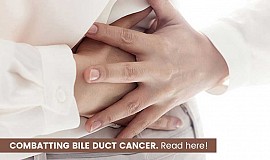About Bile Duct Cancer (CHOLANGIOCARCINOMA)
Bile duct cancer also known as cholangiocarcinoma is a cancer which starts in the cells lining one of the ducts of biliary system which carry bile from liver to intestine. It is a rare type of cancer which is more common in men at the age of 50-70 years than women. Cholangiocarcinoma accounts for 10-15% of all primary hepatobiliary malignancies that can occur in different locations in the biliary system. When it affects the bile duct within the liver it is called intra-hepatic cholangicarcinoma. When it affects the bile duct outside the liver it is called extra hepatic.
Risk Factors:
Exact cause of the disease is unknown; however most of the risk factors associated are due to the inflammation and fibrosis of biliary tract.
- Primary sclerosis cholangitis: It is a type of inflammation of the bile ducts that causes hardening and scarring of bile ducts.
- Recurrent (hepatolithiasis) Fibro polycystic disease like Caroli’s disease which is a rare congenital disorder and choledochal cysts results in major complication i.e. cholangiocarcinoma
- Asian liver flukes: Liver flukes are the cause of major health problems. There are three bile duct flukes which are acquired by humans who eat raw fish: Clonorchis sinensis, Opisthorchis viverrini and O.felineus. The flukes are about one cm in length and have a sucker that attaches to the intrahepatic bile duct epithelium, which then lives in the biliary system for approximately ten years. There is strong epidemiological evidence linking chronic biliary tract disease with bile duct flukes and leading to the ultimate development of cholangiocarcinoma
- Toxins: Few toxins like thorotrast, dioxin and polyvinyl chloride are also linked with Cholangiocarcioma
- Chronic liver disease: Scarring of the liver caused by a history of chronic liver disease increases the risk of cholangiocarcinoma.
- Other factors: There are few less established risk factors like Hepatitis C & B virus, alcohol, smoking, ulcerative colitis, obesity and diabetes
linkSymptoms:
Usually in cholangiocarcinoma, symptoms starts when the bile duct is blocked due to the tumor. Obstruction occurs early when the tumor is in the common bile duct or common hepatic duct as compared to perihilar or intrahepatic tumor. These symptoms are:
- Jaundice
- Pruritus
- Dark yellow urine
- Discolouration of the skin and eyes (yellow color)
- Loss of appetite
- Clay coloured stool
- Vomiting/nausea
- Abdominal pain
- Weakness
- Weight loss
linkDiagnosis:
- Blood tests: Liver function tests helps to measure the level of bilirubin and alkaline phosphatise which in turn help to assess the functioning of bile duct. Tumor marker tests (CEA and CA19-9) Cholangiocarcinoma may cause high levels of carcinoembryonic antigen (CEA) and CA19-9 in the blood. However, these tests are not confirmatory but help to assess the progress of ongoing treatment
- Ultrasound: An ultrasound uses sound waves to create a picture of the internal organs. Any abnormality or tumor seen during USG is confirmed by further investigations like CT SCAN
- Biopsy: In cholangiocarcinoma biopsy is usually performed during a procedure called a percutaneous transhepatic cholangiography (PTC) or endoscopic retrograde cholangiopancreatography (ERCP) which is done to treat obstructive jaundice. At times biopsy is not possible, in this situation people are treated for bile duct cancer based on other test results and symptoms
- CT scan: A CT scan is used to measure the tumor’s size and spread of the disease. Sometimes, a special dye called a contrast medium is given before the scan to provide better details of the image
- MRI cholangiopancreatography(MRCP): A contrast medium may be injected into a patient’s vein or given as a pill to swallow before the MRI to create a clearer picture
- Percutaneous transhepatic cholangiography (PTC): A contrast medium through a thin needle is inserted into the bile duct which shows the blockage and its location on the x-ray. This is important in planning the treatment ahead
- Endoscopic retrograde cholangiopancreatography(ercp): It is a procedure that helps examine the pancreas and bile ducts. A bendable, light tube about the thickness of index finger is placed through the mouth into the stomach reaching the top part of the small intestine (duodenum)
linkPrevention:
There is no known way to prevent the disease as most of the risk factors are beyond our control. However, there are few things that can lower the risk and these include:
- Treat hepatitis infections which results in cirrhosis. Get vaccinated for hepatitis B virus
- Quit smoking
- Avoid eating raw fish
- If diagnosed with liver fluke infection, take proper medication
- Include more of fruits and vegetables in your diet and less of processed food and red meat
linkTreatment:
The extent of a bile duct cancer is an important factor in determining the treatment options. As per the conventional methods, the best bile duct cancer treatment is surgery.Treatment possibilities for Cholangicarcinoma depend upon the stage in which cancer is diagnosed. Chances of recovery are always better when diagnosed in early stages. At Cancer Healer Center, the team of highly trained professionals works together to form the most appropriate treatment plan suitable for the stage and extent of the disease. Immunotherapy at Cancer Healer Center helps to recover the cases even when the disease is diagnosed in an advanced stage or in metastatic stage like liver metastasis. The therapy helps to enhance the immune cells of the body which fight back against the cancer cells and help to control the disease. It treats without causing any side effects and this is the reason it can be given to the patients suffering from jaundice due to destruction of bile duct. It is one of the most effective bile duct cancer treatment. Medicines help to improve appetite and reduce weakness in patients suffering from jaundice or impaired liver function due to metastasis. It helps to maintain a better quality of life with better chances of survival. For better guidance, Kindly contact the Cancer Healer Team!




